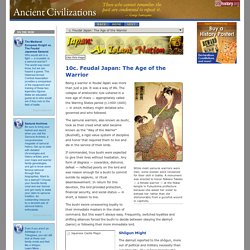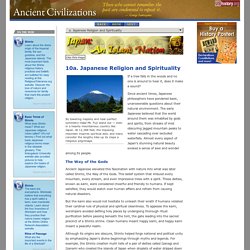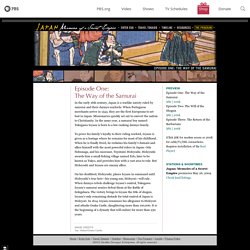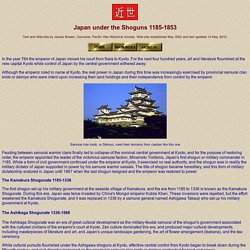

Feudal Japan. Edo Japan, A Virtual Tour. Brief History of the Samurai. The following is an attempt to briefly explore the military aspects of Japan's history from the Early through Pre-Modern periods.

The richness of Japanese history cannot be entirely denied, however, and the reader will certainly find references to matters and concepts not entirely related to the samurai. The first chapter, for instance, deals with events that occurred centuries before the samurai as we know them even existed. Yet to fully understand the samurai and their history, one must occasionally step back and admire the whole picture. This effort does not pretend towards anything more then it is, but we hope that the patient reader may find it useful in his or her own studies. Samurai and Bushido - Facts & Summary. In the mid-19th century, the stability of the Tokugawa regime was undermined by a combination of factors, including peasant unrest due to famine and poverty.

The incursion of Western powers into Japan–and especially the arrival in 1853 of Commodore Matthew C. Perry of the U.S. Navy, on a mission to get Japan to open its doors to international trade–proved to be the final straw. Feudal Japan: The Age of the Warrior. While most samurai warriors were men, some women were renowned for their skill in battle.

A monument was erected to honor Nakano Takeko — a female warrior — at the Hokai temple in Fukushima prefecture because she asked her sister to behead her rather than die dishonorably from a gunshot wound in captivity. Being a warrior in feudal Japan was more than just a job. It was a way of life. The collapse of aristocratic rule ushered in a new age of chaos — appropriately called the Warring States period (c.1400-1600) — in which military might dictated who governed and who followed. The samurai warriors, also known as bushi, took as their creed what later became known as the "Way of the Warrior" (Bushidô), a rigid value system of discipline and honor that required them to live and die in the service of their lords.
If commanded, true bushi were expected to give their lives without hesitation. Japanese Religion and Spirituality. Its towering majesty and near-perfect symmetry make Mt.

Fuji stand out — even in a heavily mountainous country like Japan. At 12,388 feet, the imposing mountain inspires spiritual awe, and many consider the lengthy hike up its slope a religious pilgrimage. If a tree falls in the woods and no one is around to hear it, does it make a sound? Since ancient times, Japanese philosophers have pondered basic, unanswerable questions about their natural environment. The early Japanese believed that the world around them was inhabited by gods and spirits, from streaks of mist obscuring jagged mountain peaks to water cascading over secluded waterfalls. Medieval Japan - Home. MEDIEVAL JAPAN - HOME. Medieval Japan☮ - Home. Simply Japan - Home. Edo Japan, A Virtual Tour. Japan: Memoirs of a Secret Empire . Shogun. Japan: Memoirs of a Secret Empire . Program Two - The Will of the Shogun. With Ieyasu in control, peace settles over Japan, and a new society based on the samurai ethics of obedience and loyalty is established.

In 1600, William Adams becomes the first Englishman to set foot in Japan. Impressed by European trading vessels, Ieyasu asks Adams to help him build his own fleet. Aware that the English have no interest in converting the Japanese to Christianity, Ieyasu decides to expel the Portugese and Spanish who often combine missionary work with trade. As Shogun, Tokugawa Ieyasu has united the daimyo warlords. When he dies at 72, his vision of a strictly controlled class system based on the rule of the samurai is a reality. Foreign missionaries have been expelled from Japan, but still Iemitsu fears the influence of Christianity.
IMAGE CREDITS Top: Tokugawa Iemitsu/Hasedera Temple. Japan: Memoirs of a Secret Empire . Program One - Way of the Samurai. In the early 16th century, Japan is a warlike society ruled by samurai and their daimyo warlords.

When Portuguese merchants arrive in 1543, they are the first Europeans to set foot in Japan. Missionaries quickly set out to convert the nation to Christianity. In the same year, a samurai boy named Tokugawa Ieyasu is born to a low ranking daimyo family. To prove his family's loyalty to their ruling warlord, Ieyasu is given as a hostage where he remains for most of his childhood. When he is finally freed, he reclaims his family's domain and allies himself with the most powerful rulers in Japan: Oda Nobunaga, and his successor, Toyotomi Hideyoshi. On his deathbed, Hideyoshi, places Ieyasu in command until Hideyoshi's true heir—his young son, Hideyori—will rule. IMAGE CREDITS Top: Hideori/Osaka Castle. ABC online education. ABC online education.
ABC online education. Japan: Memoirs of a Secret Empire . Shogun. Ashikaga Shogunate. Japan under the Shoguns. Japan under the Shoguns 1185-1853 Text and Web-site by James Bowen, Convener, Pacific War Historical Society.

Web-site established May 2002 and last updated 14 May 2010. In the year 784 the emperor of Japan moved his court from Nara to Kyoto. For the next four hundred years, art and literature flourished at the new capital Kyoto while control of Japan by the central government withered away. Although the emperor ruled in name at Kyoto, the real power in Japan during this time was increasingly exercised by provincial samurai clan lords or daimyo who were intent upon increasing their land holdings and their independence from control by the emperor. Samurai clan lords, or Daimyo, ruled their domains from castles like this one. Tokugawa Shoguns of Japan (1603 - 1868) By Kallie Szczepanski Updated October 14, 2015.

For more than 100 years before the Tokugawa Shogunate took power in Japan in 1603, the country wallowed in lawlessness and chaos during the Sengoku or "Warring States" period (1467-1573). Japan Reference.